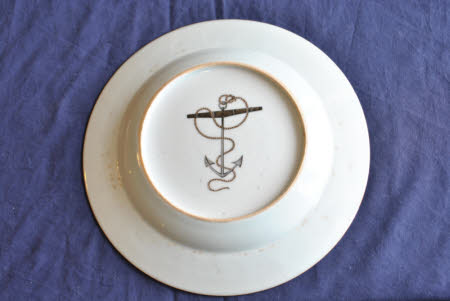Armorial plate
Category
Ceramics
Date
circa 1743 - circa 1745
Materials
Porcelain painted in enamel and gold
Measurements
230 mm (Dia)
Place of origin
Jingdezhen
Order this imageCollection
Shugborough Estate, Staffordshire
NT 1271545.1.18
Caption
This may have been a trial plate prepared circa 1743 – 1745 to gain the approval of Commodore Anson before an order was placed for a large table service which today numbers 206 pieces. It is the only example of this pattern in the collection. The centre depicts a stock export pattern of a pine tree entwined with a floral garland, rather than the breadfruit tree and while the crest and coat of arms are identical to those on the rest of the service, there are sprays of stylized hibiscus in gold edged in iron red, rather than the views of Plymouth Sound and Pearl Harbour.
Summary
Table plate, one of 114, possibly a trial or sample plate, part of a 206 piece Chinese porcelain armorial service. Made in Jingdezhen, China and decorated in Gunagzhou (Canton) circa 1743 – 1745 in enamel and gold. The unique plate shows the arms of Anson quartering Carrier of Wirksworth, with a central design including pine trees and a pair of dogs. On the rims of the plate are designs in gold leaf. The base features a ship's anchor entwined with a cable.
Full description
Table plate, one of 114, possibly a trial or sample plate, part of a 206 piece Chinese orcelain armorial service. Made in Jingdezhen, China and decorated in Gunagzhou (Canton) circa 1743 – 17457 in enamel and gold. The unique plate shows the arms of Anson quartering Carrier of Wirksworth, with a central design including pine trees and a pair of dogs. On the rims of the plate are designs in gold leaf. The base features a ship's anchor entwined with a cable. Commodore George Anson (1697 – 1762) was created 1st Lord Anson, Baron of Soberton, co. Southampton in 1747 and First Lord of the Admiralty in 1748 and circumnavigated the globe in the HMS Centurion (1740 – 44). The armorial dinner service was commissioned for him circa 1743 by European merchants of Canton in gratitude for the assistance given by the crew of his ship in extinguishing a fire in that city. The majority of the service is decorated in polychrome enamels in the ‘famille rose’ palette and gold. Painted around the rim are the crest of a griffin's head and the coat of arms of Anson quartering Carrier of Wirksworth within a Rococo cartouche. These two features are between two long panels of waterscapes, one perhaps depicting a view of ships anchored on the Pearl River, with a pagoda, junks and sampans between a tower and a ruin, and the other an English scene interpreted as Plymouth Sound in Devon with ships flying the British flag between a lighthouse and another ruin. The centres are painted with the life-saving breadfruit tree draped with a floral garland, flanked on the right with symbols of the Absent Master, two pining dogs, bagpipes, a bonnet, a pair of crossed crooks and in the distance a flock of sheep, and on the left a palm tree and other symbols of love, an altar with two flaming hearts, a pair of ‘billing’ doves, a bow and a cupid’s quiver. On the base is a ship's anchor entwined with a cable. A single plate features a slightly different design to the remainder of the service, with pine trees in the centre, rather than a breadfruit tree and a gold leaf design on its panel rims rather than the waterscapes. This may have been a trial plate for the large dinner service and so it may date circa 1743-45, or for an additional service that was never completed. The discovery of Breadfruit trees on Tinian Island, a Spanish possession in the Pacific, provided the crew of The Centurion, suffering from scurvy, with much needed sustenance. The depiction on the service was apparently based on sketches provided by Sir Peircy Brett (1709-81), Captain of The Centurion, later published as ‘A View of the Watering Place at Tenian’ in ‘A Voyage Around the World, in the Years MDCCXL,I,II,III,IV’, London, 1748, pl. XXIV. Variations of the pattern subsequently appear on other export services, circa 1745-50 and on Worcester porcelain, circa 1758, known as the Valentine pattern. The collection at Shugborough features a number of objects from H.M.S. Centurion including plaques (NT Inventory Numbers 1271010 and 1270721) and a canon tamp (NT Inventory Number 1271011). Also included in the collection are medals commemorating Lord Anson’s 1740 – 44 voyage of circumnavigation (NT Inventory Number 1270606.1) and a print of six scenes from the voyage (NT Inventory Number 1271174).
Provenance
Ordered by Commodore George Anson (1697 – 1762) between 1743 and 1747. On his death it was bequeathed to his brother Thomas Anson (1695 – 1773), of Shugborough, and hence by descent bequeathed to Thomas Edward Anson (1883 – 1960), the 4th Earl of Lichfield. Accepted by H.M. Treasury in lieu of estate duties following the death of the 4th Earl and given on loan to The National Trust for display at Shugborough Hall in March 1966. Transferred as a gift to The National Trust by H.M. Treasury on the 30th October 1984.
References
Jackson-Stops 1985: Gervase Jackson-Stops (ed.), The Treasure Houses of Britain: five hundred years of private patronage and art collecting, exh. cat. The National Gallery of Art, Washington, New Haven and London 1985, CAt. No. 377

